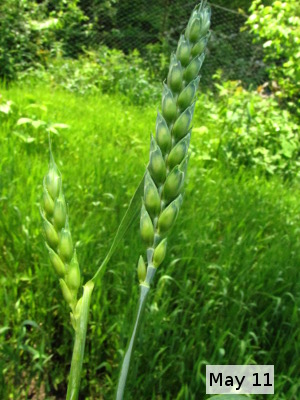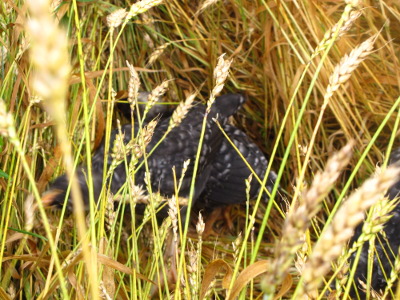
When should I harvest wheat?
 How do you know when your
wheat is ripe? First, let's start with the technical answer.
How do you know when your
wheat is ripe? First, let's start with the technical answer.
If you grew winter
wheat, in late
spring the heads will bulk up and turn beautiful, then the plant will
start to turn brown. At that point, squeeze a seed between your
thumb and forefinger to test it once or twice a week. At first,
the wheat seeds will exude a milky substance just like sweet corn does
when it's ripe, but then the punctured seeds will stop oozing (although
they will still dent under your thumbnail.)
You can start harvesting
as soon as the wheat seeds pass the milk stage, although the grains
will need to dry up and harden a bit before they're ready to eat.
It's best to go ahead and harvest on the early side since if you wait
too long, the heads will "shatter", meaning that the grains will fall
onto the ground.
 Now for the fun way to tell
if your wheat is ready to harvest --- that overlooked part of your
garden will suddenly become a magnet for animal life. First, it
was just a cardinal who took to perching on the gate of the
wheat-filled chicken pasture, but then our second
round of chicks
decided it was worth leaving the ragweed forest to see what all the
fuss was about. When I found six chickens knocking down the wheat
stalks, I knew it was time to pull the grain out of there.
Now for the fun way to tell
if your wheat is ready to harvest --- that overlooked part of your
garden will suddenly become a magnet for animal life. First, it
was just a cardinal who took to perching on the gate of the
wheat-filled chicken pasture, but then our second
round of chicks
decided it was worth leaving the ragweed forest to see what all the
fuss was about. When I found six chickens knocking down the wheat
stalks, I knew it was time to pull the grain out of there.
As for how to harvest the wheat ---
we're still crossing that bridge. Stay tuned for a later post.
Want more in-depth information? Browse through our books.
Or explore more posts by date or by subject.
About us: Anna Hess and Mark Hamilton spent over a decade living self-sufficiently in the mountains of Virginia before moving north to start over from scratch in the foothills of Ohio. They've experimented with permaculture, no-till gardening, trailersteading, home-based microbusinesses and much more, writing about their adventures in both blogs and books.
Want to be notified when new comments are posted on this page? Click on the RSS button after you add a comment to subscribe to the comment feed, or simply check the box beside "email replies to me" while writing your comment.

I was reading yet another article from a major media outlet about the predicted rising costs of food, and how with climate change we're going to actually be in a lot of trouble just growing the food let alone finding ways to pay for it.
(big intro to related question)...
Is it worth the time / money to grow wheat? You were talking about carbohydrate sources back in the week about the US Food Pie Chart. What are the best plants for a city person to grow to get carbohydrates? Veggie gardens are making a comeback but I wonder about rice, potatoes, wheat, etc -- viable for the city?
If you play all of your cards right, Irish potatoes (white potatoes) will give you the most calories per acre (17.8 million vs. 6.4 million for wheat and 12.3 million for field corn.) In my own trials, I've actually gotten even more calories from certain carrot, grain amaranth, and sweet potato beds than from my potatoes since we grow a variety of potato that is delicious but not quite as high yielding.
In general, I'd say that grains are a fun experiment, but that if you're really serious about growing your carbs, stick to the simplest choices that don't need special threshing, winnowing, etc. If you already grow vegetables, potatoes aren't very hard to learn to grow, while grain is a whole different ballpark. But try several of the high carb vegetables your first year to figure out which ones suit your climate and soil --- you might have better luck with sweet potatoes than white potatoes like we did.